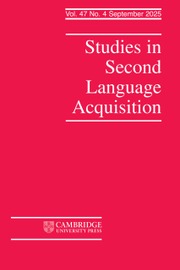Article contents
Memory, Attention, and Inductive Learning
Published online by Cambridge University Press: 01 March 1999
Abstract
Three experiments investigated the relationship between memory for input andinductive learning of morphological rules relating to functional categories in a semiartificial formof Italian. A verbatim memory task was used as both the vehicle for presenting sentences and as acontinuous measure of memory performance. Experiments 2 and 3 introduced increasinglyexplicit manipulations of attention to form compared to Experiment 1. In all experiments therewere strong relationships between individual differences in memory for input as measured earlyin the experiment and eventual learning outcomes, and in Experiments 2 and 3 learningform-form (but not form-function) rules was related to vocabulary learning efficiency (taken as ameasure of phonological long-term memory ability). These relationships along with the lack ofan effect of feedback in Experiment 3 suggest that subjects tended to adopt a data-driven, asopposed to conceptually driven, mode of learning. However, the fact that the introduction ofhighlighting and vocabulary pretraining in Experiment 2 had a large impact on learning withoutimproving early memory is taken to suggest that knowledge of distributional rules does notsimply emerge out of memory encodings of the relevant forms but depends upon the appropriateallocation of attention over relationships between input elements at the time of encoding.
Information
- Type
- Research Article
- Information
- Copyright
- © 1999 Cambridge University Press
- 71
- Cited by

